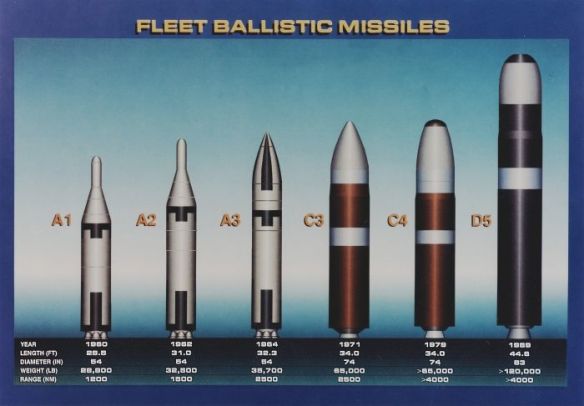SLBM family: UGM-27A, UGM-27A, UGM-27C, UGM-73A, UGM-96A, UGM-133A
The Poseidon submarine-launched ballistic missile, the follow-on system to the Polaris program, was a two-stage, solid-propellant missile designed to be launched from a submerged fleet ballistic missile (FBM) submarine. It was 2 feet longer than the 32- foot Polaris A3 missile but had a much larger diameter (74 versus 54 inches) and was 30,000 pounds heavier. Despite the increase in size of the Poseidon missile, the growth potential of the FBM submarines allowed Poseidon missiles to fit into the same sixteen missile launch tubes that had earlier carried Polaris missiles. The Poseidon C3 missile was a substantial improvement over Polaris. It provided a greater payload capacity and was capable of delivering multiple warheads, widely spaced, on separate targets over a variety of target footprints. This capability of using multiple independently targetable reentry vehicles (MIRVs) enabled Poseidon to cover a wide range and hold at risk a greater number of targets with nuclear weapons.
The Poseidon C3 missile had a range of 2,500 nautical miles and was the first submarine ballistic missile to be capable of targeting a number of different targets located within the “footprint” of the missile (the area in which individual warheads can be delivered by a single missile). Each 64,000-pound Poseidon C3 could carry up to fourteen Mark 3 reentry bodies. These could be targeted to maximize damage against a single target or targeted against fourteen individual targets. It was also possible to extend the range of the Poseidon by offloading warheads or penetration aids (devices intended to complicate any efforts at missile defense from the payload. Apart from the much-increased size and weight, Poseidon’s main advantage over the Polaris A3 missile was its ability to deliver a warhead to multiple targets. Poseidon C3 also incorporated substantial improvements over Polaris in accuracy and resistance to countermeasures.
The Poseidon missile was deployed initially on thirty-one of the U. S. Navy’s forty-one FBM submarines. The first ten fleet ballistic missile submarines to be built, including five in the George Washington class and five in the Ethan Allen class, were not retrofitted to carry Poseidon. The first launching of a Poseidon missile from a submerged submarine occurred on August 3, 1970, from the USS James Madison (SSBN 627) off the coast of Florida near Cape Canaveral. The Poseidon C3 became operational on March 31, 1971, when the USS James Madison began its initial operational patrol carrying sixteen Poseidon C3 missiles.
In addition to being deployed on Polaris submarines, Poseidon C3 missiles were deployed on submarines, also named Poseidon, that were specially converted to accommodate the larger and heavier missile. In 1970, four SSBN-627 class submarines were converted to carry the Poseidon C3 missile. Although some Polaris submarines were later converted to carry Poseidon, the new Poseidon submarines, at 425 feet long, were much larger than the submarines designed to carry the Polaris missile. They had the same beam width (33 feet) and displaced 8,250 tons (versus 6,700 tons for Polaris). In the 1980s, of the thirty-one Poseidon FBM submarines, twelve were later backfitted to carry the Trident I (C4) missile. The last Poseidon SSBN offloaded its Poseidon C3 missiles and was retired from service in September 1992 (see Polaris SSBNs/SLBMs).
References “Poseidon,” available at http://www.warships1.com/ Weapons/WMUS_Poseidon. htm. Spinardi, Graham, From Polaris to Trident: The Development of U. S. Fleet Ballistic Missile Technology
(New York: Cambridge University Press, 1994). “Submarine Launched Ballistic Missiles,” from United States Nuclear Forces Guide, Federation of American Scientists, available at http://www.fas.org/nuke/ guide/usa/slbm.
